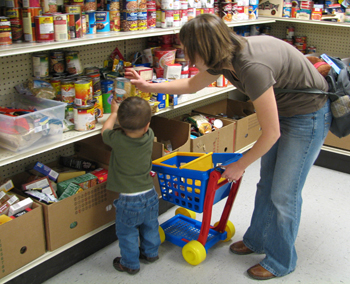Food banks absorb clients of food bank closing at St. Vincent
St. Vincent de Paul, Spokane County’s largest neighborhood food bank and a 112-year-old agency that served the working poor, closed its doors on Feb. 29.
 |
| Salvation Army food bank clients choose food. |
In its last weeks, volunteers and staff worked with Second Harvest and the Salvation Army to redirect their more than 4,000 clients per month—60,000 individuals a year—to 20 other neighborhood food banks.
St. Vincent de Paul gave out about 1 million pounds—nearly one fourth—of the 4.5 million pounds of food Second Harvest distributes in the county. It handles more than 13 million pounds of food for the whole region.
Second Harvest and The Salvation Army are collaborating to ensure that St. Vincent de Paul clients know, based on their zip codes, where their neighborhood food banks are.
Jason Clark, executive director of Second Harvest, expects it will take a few months to work out referrals, monitor where clients go and reallocate food to keep up appropriate supplies in the right places to serve the people.
Major John Chamness, regional coordinator for Salvation Army Inland Northwest, said: “We are saddened by this unfortunate situation—losing one of our community partners—and we are working with Second Harvest to ensure that the families and individuals who have relied upon St. Vincent de Paul’s services will continue to receive the food they need.”
The Salvation Army fed about 700 families a month at 2020 N. Division, before it moved its food bank in October from there to its Family Resource Center, 204 W. Indiana. Since then, it has served 1,100 people a month. It expects to assist 4,000 clients in March, absorbing many of the St. Vincent clients, said Christy Markham, development director.
“When we moved to our current location, we more than doubled the square footage of our food bank and added bulk storage and a reach-in freezer and refrigerator,” said Kim Petrusek, Salvation Army social services director.
Rhonda Allen, program manager at the Family Resource Center since November, said she expects many St. Vincent clients to come there, because it is a multi-service center, not just a food bank, as St. Vincent had been.
The Salvation Army provides clothing, furniture and household items at their thrift store at 2020 N. Division. They also offer life skills classes, such as helping people stretch their food dollars.
“Our food bank is a choice food bank. That means clients ‘shop’ to select what they want and will eat,” she said, noting that they can choose based on foods their children like to eat and on their dietary restrictions.
Many live on limited incomes with Social Security or disability and need skills to stretch those funds, said Rhonda. The Salvation Army also has a shelter, transitional housing, counseling and assistance with finding employment.
While St. Vincent de Paul was a walk-in food bank, The Salvation Army’s food bank is by appointment from 8:30 a.m. to 5 p.m., Mondays, Tuesdays, Thursdays and Fridays. Wednesdays from 1 to 6:30 p.m. are walk-ins only.
“We also give the senior and WIC (Women’s, Infants’ and Children’s) government commodity boxes on a walk-in basis throughout the month,” Rhonda said.
Christy added that The Salvation Army will need more volunteers and more funds for more staff to meet the needs of the additional clients.
“It has been a long road of hard decisions,” said St. Vincent de Paul board president Michael Cain, citing declining membership in the local Society of St. Vincent de Paul and competition with other charities for resources.
Lucinda Kay, who has been in charge of public relations during the closure, said the lack of funds began when discount stores were able to offer prices competitive with the thrift stores for new items, plus the emergence of online marketing.
That led the Spokane outlet to close its two thrift stores, which had supplied a major portion of the $360,000 they needed to serve the working poor, seniors on fixed incomes and families in crisis, she explained. St. Vincent de Paul funded its operations primarily through its thrift stores.
When they sold the stores, Lucinda said, there was funding for one year, and it was hard to raise the amount needed to replace the income with donations.
Clergy and leaders in nonprofit agencies who refer people to food banks need to know to refer them to a neighborhood food bank rather than St. Vincent de Paul.
St. Vincent de Paul food banks outside Spokane—in Colville, Coeur d’Alene, Dayton, Kellogg, Pasco, Post Falls, Pullman and Walla Walla—and St. Vincent food bank outlets in parishes will continue to operate.
For information, call 534-6678 or 325-6810.
Copyright © 2008 The Fig Tree - By Mary Stamp




